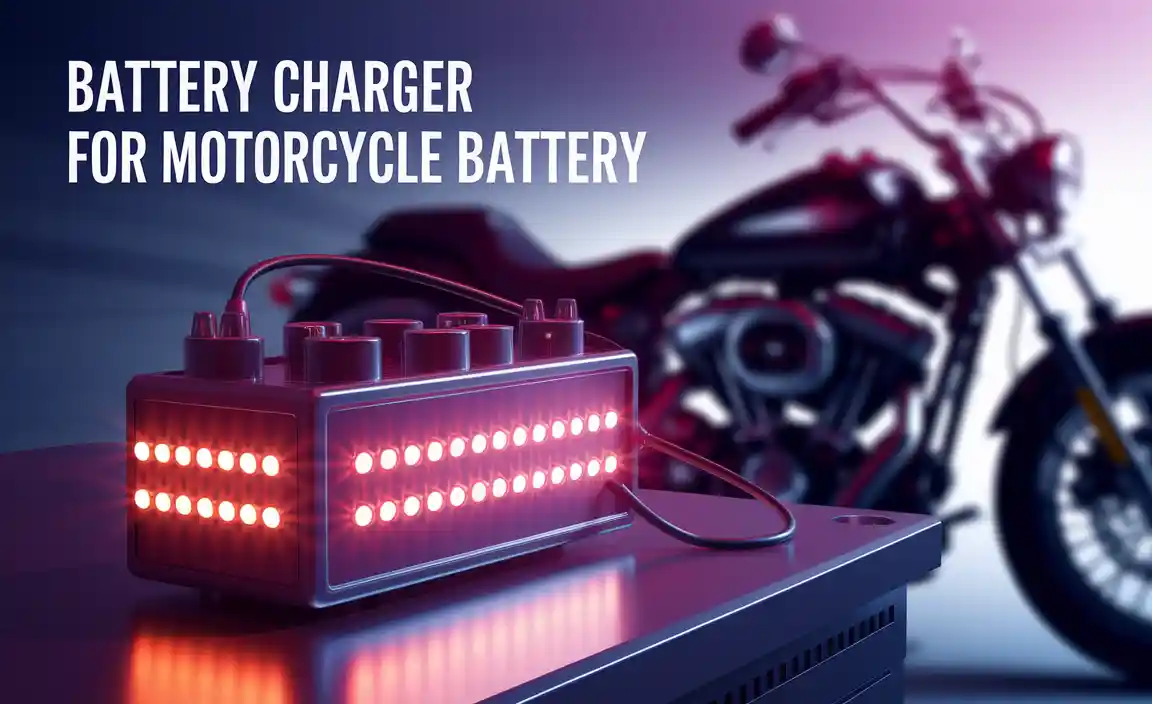Have you ever wondered why your car battery dies when you least expect it? It can be frustrating. You might jump into your car, ready to go, only to find it won’t start. This situation often happens due to battery draw. But what is battery draw? Simply put, it’s when something in your car keeps using battery power even when the engine is off. That can drain your battery quickly.
Imagine leaving a light on in your room when you go to sleep. The next morning, your room is dark. Why? Because the light used up all the battery power! It’s the same with cars. And just like you would want to find out what’s draining your room’s power, you need to learn how to test for battery draw in your vehicle.
In this article, you’ll discover simple steps to check for battery draw. Knowing how to do this can save you from unexpected dead batteries. It can help you keep your car running smoothly and give you peace of mind. Ready to dive in? Let’s explore how to test for battery draw together!
How To Test For Battery Draw: Easy Steps And Tips

How to Test for Battery Draw
Testing for battery draw can help you find hidden issues draining your car battery. To start, use a multimeter to measure the current draw. Disconnect the negative battery cable and connect the multimeter between the cable and the terminal. A reading over 50 milliamps means there’s a draw. Check for sources like lights or faulty components. Remember, a simple test can save you from unexpected battery failures, keeping your vehicle reliable and stress-free.Understanding Battery Draw
Definition and significance of battery draw. Common symptoms of battery drain in vehicles.Battery draw happens when a vehicle’s battery loses power even when the car is off. This is important because it affects the car’s ability to start. Signs of battery drain include:
- Dim lights or dashboard signs
- Slow engine crank
- Clicking sound when turning the key
Understanding these symptoms can help you catch battery issues early. A healthy battery ensures your car runs smoothly.
What causes battery drain in vehicles?
Common causes of battery drain include faulty electrical systems, light left on, or weak connections.
Tools Needed for Testing Battery Draw
Essential tools for testing (multimeter, insulated wire, etc.). Safety precautions to take while preparing for the test.To test for battery draw, you need a few basic tools. A multimeter is essential. It helps measure the battery’s voltage. You will also need insulated wire to safely connect your tools. Don’t forget gloves to protect your hands. Safety is important! Always turn off the car before starting. This keeps you safe from shocks and accidents.
What should I consider for safety while testing?
Before testing, ensure you’re aware of these safety tips:
- Wear gloves to prevent electric shock.
- Use insulated tools that prevent accidents.
- Turn off vehicles and devices before handling wires.
Step-by-Step Guide to Testing for Battery Draw
Preparing the vehicle for testing. Setting up the multimeter for accurate readings.First, make sure your vehicle is in a safe area. Park it on a flat surface and turn off all lights. Open the hood and relax, maybe grab a snack while the battery cools down. Next, grab your multimeter. Set it to the DC amps setting—this part is super important! Now, attach the red probe to the battery’s positive terminal and the black probe to the negative terminal. Voilà! You’re ready to check for battery draw.
| Step | Action |
|---|---|
| 1 | Park safely and off. |
| 2 | Turn off all lights. |
| 3 | Set multimeter to DC amps. |
| 4 | Connect red and black probes. |
Interpreting Multimeter Readings
Understanding normal vs. excessive battery draw readings. How to document and analyze your results.Readings from a multimeter can tell you a lot about battery draw. Normal battery draw is usually below 50 milliamps. If you see numbers that are much higher, that’s excessive battery draw. It might mean something is wrong with your car’s electrical system. Be sure to document your readings consistently. Write them down and compare over time. This helps you see trends.
- Normal draw: below 50 mA
- Excessive draw: above 50 mA
- Document readings: keep a notebook or log
How do you analyze the multimeter readings?
It’s important to check and compare your readings over time. Look for patterns and changes. This will help you find problems quickly.
Identifying the Source of Battery Drain
Common electrical components that may cause battery draw. How to isolate circuits and pinpoint the problem area.Battery drain can sneak up on you. Some common parts can cause this issue. Think about lights, radios, and alarms. They may run even when the car is off, using power.
To find the problem, you can check circuits one at a time. Here’s how to do it:
- Start by disconnecting the negative battery cable.
- Use a multimeter to measure current.
- Reconnect each circuit until you see power usage.
This way, you’ll find the exact part that is causing the drain!
What are some common causes of battery draw?
Common causes of battery draw include lights, radio, and alarm systems. These components can keep running even without the engine on.
What steps can I take to isolate the problem?
To isolate the problem, check each circuit individually. This will help you pinpoint the exact source of the battery drain.
Troubleshooting Battery Draw Issues
Techniques to fix common causes of battery drain. When to seek professional help vs. DIY solutions.Battery drain can be annoying. To fix it, look for common causes. Some may be simple DIY fixes, like cleaning battery connections or checking for lights that stay on. However, some problems may need an expert. Here’s a quick guide:
- Check lights and electrical devices.
- Inspect battery terminals for dirt or corrosion.
- Test for faulty wiring.
- Examine the alternator for issues.
If these steps don’t work, it’s time to seek professional help. They have the right tools to find out what’s wrong.
How can you tell if a battery drain problem is serious?
If the car won’t start after charging, check if the battery is old. A battery older than three years may need replacing. Seek help if you’re unsure!
Preventive Measures to Avoid Future Battery Draw
Best practices for vehicle maintenance. Tips for energyefficient use of electronic devices in vehicles.Taking care of your vehicle helps prevent future battery draw problems. Regular checks and easy habits can keep things running smoothly. Here are some best practices:
- Check the battery connections. Make sure they’re tight and clean.
- Turn off all lights and devices when the car is off.
- Park your car in the garage or shaded area to avoid extreme temperatures.
- Use energy-efficient devices. They consume less power.
Small steps can make a big difference!
How can I maintain my vehicle to prevent battery issues?
Perform regular checks, keep devices off, and maintain battery health.
Conclusion
In summary, testing for battery draw is simple. Use a multimeter to check your car’s battery drain. Disconnect the negative cable and connect the multimeter to find any excess power usage. If you see high numbers, look for the cause. We can save battery life by turning off lights and unplugging accessories. For more tips, keep reading!FAQs
What Are The Tools Required To Measure Battery Draw In A Vehicle Or Electronic Device?To measure battery draw, you need a few basic tools. First, use a multimeter, which measures electric current. You also need a good set of wires to connect everything. If your device is a car, you might need a clamp meter to check without touching wires. Remember to follow safety rules when using these tools!
How Can You Identify Which Component Is Causing Excessive Battery Drain During A Draw Test?To find which part is using too much battery, we can do a draw test. First, you turn off everything and check the battery’s power use. Then, you turn on each part one by one. If the battery drain goes up a lot when you turn on a part, that part is the problem.
What Is The Process For Safely Disconnecting A Battery While Testing For Draw?First, make sure the car is turned off and parked safely. Then, find the battery and look for the negative terminal, which is usually marked with a minus (-) sign. Use a wrench to carefully loosen and remove the negative cable. This keeps you safe while you test for draw. Always wear safety glasses to protect your eyes.
How Do You Interpret The Readings Obtained From A Multimeter When Testing For Battery Draw?When you use a multimeter to test battery draw, you look at the numbers it shows. If the number is low, it means the battery isn’t being used much. A very high number means something is using a lot of battery power. We want a low number to save the battery. If the reading is too high, you might need to check for problems.
What Common Issues Can Lead To Battery Draw, And How Can They Be Diagnosed During Testing?Some common issues that can lead to battery draw are lights left on, a broken part, or a faulty radio. You can test for these problems by checking if any lights are still on after you turn off the car. We can also look for parts that might be using power when they shouldn’t. Using a special tool called a multimeter, we can measure the battery’s power drain. This helps us find out what’s causing the battery to drain too fast.



